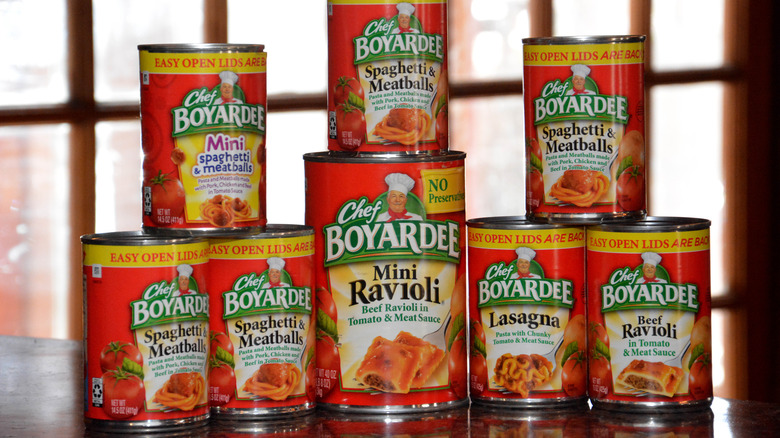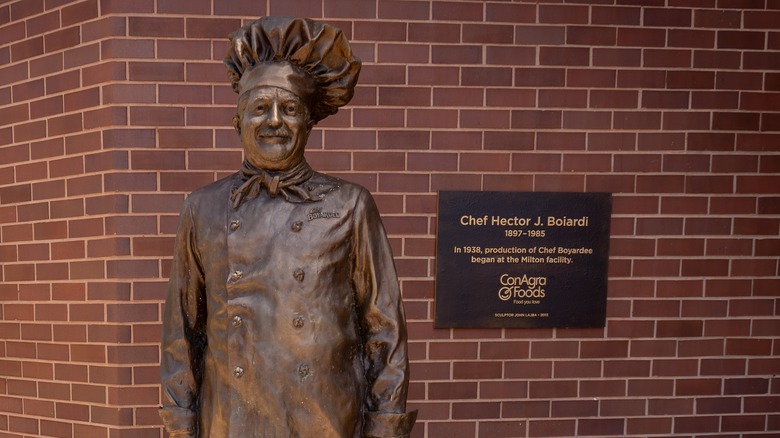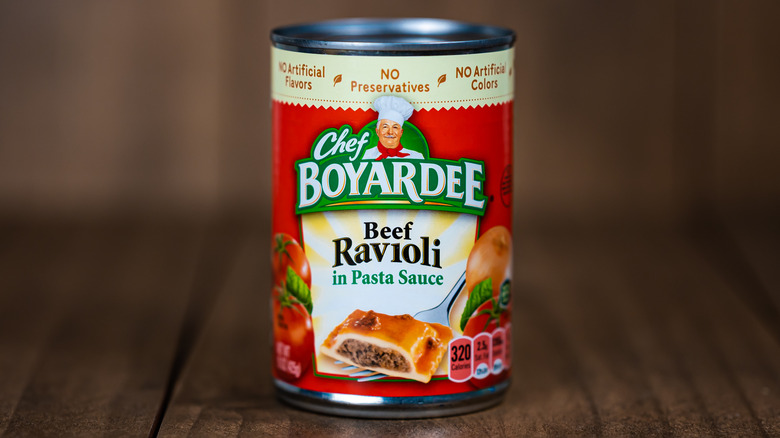How Chef Boyardee Became A Canned Food Celebrity
We may receive a commission on purchases made from links.
You've likely seen his smiling face at your local grocery store. He wears a classic chef's hat and sports a red kerchief around his neck on cans of Americanized Italian foods like mini ravioli and beefaroni. Perhaps you thought he was just a made-up mascot for the Chef Boyardee brand. But like KFC's famous Colonel Sanders, Chef Boyardee was a real person. Born Ettore Boiardi in Piacenza, Italy, in 1897, he immigrated to the U.S. in 1914 and adopted the anglicized first name Hector. Just a year later, at 17 years old, he had already risen to the role of head chef at Manhattan's prestigious Plaza Hotel.
Later in 1915, while working at The Greenbriar, a swanky resort in West Virginia under the same ownership as the Plaza Hotel, Boiardi got a prestigious catering gig. He oversaw the food service for U.S. President Woodrow Wilson's wedding, which helped put Chef Boyardee on the map. In 1918, Wilson also tapped the chef to serve dinner to 2,000 soldiers returning to the States at the end of World War I. Within a few years, Boiardi became the most famous chef in America, a status that he would parlay into a canned goods empire.
From celebrity chef to canned pasta king
In 1924, Chef Hector Boiardi launched a successful Italian restaurant in Cleveland, Ohio, so successful, in fact, that his customers began asking for his recipes and take-home portions of his dishes. He decided to begin selling his pasta sauce, which he initially bottled in recycled milk containers. It was an instant hit and in 1928, Boiardi and his two brothers began canning pasta and sauces under the Chef Boy-ar-dee label (stylized later as Chef Boyardee), finding the phonetic spelling easier for Americans to pronounce. It was one of the first canned Italian food companies in the U.S. and helped popularize Italian food among Americans.
The company eventually outgrew its original processing plant in Cleveland and moved to rural Milton, Pennsylvania, in 1938, where Boiardi and his brothers took over an old silk mill as they continued to grow the business. By then, Chef Boyardee was already the largest importer of Parmesan cheese in the country, but wanted to find local sources for its fresh ingredients. Accordingly, one reason for the company's move to Milton was to be closer to tomato fields used for the pasta sauces. Another reason was to be closer to the East Coast markets. Even through the Great Depression, the company thrived with its low-cost, delicious products.
Boiardi's wartime contributions and lasting legacy
Chef Boyardee had grown to the point that in 1942, during World War II, the company edged out other businesses to win a contract to supply the U.S. Army with canned food for the troops. To meet demand, Hector Boiardi hired additional employees and ran his Pennsylvania factory 24 hours a day. In recognition of the company's contributions, the U.S. government would later award him the prestigious civilian honor, the Gold Star.
Although Chef Boyardee continued to grow, Boiardi decided to sell the company in 1946 to avoid laying off wartime employees (via Chef Boyardee). Despite returning to the restaurant industry and taking on other business ventures, he consulted with the new owners for several decades. He died in 1985 at 87 years old, but still lives on as the mascot for a beloved American brand of Italian food, with his anglicized name and likeness continuing to grace the company's products today. If you do indulge in some canned Chef Boyardee products, be sure to follow the essential rules of storing canned food by handling them with care and keeping them in an area with stable temperature.


